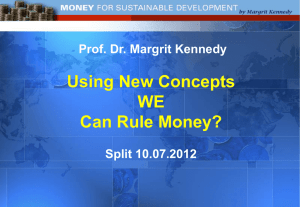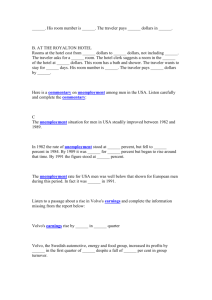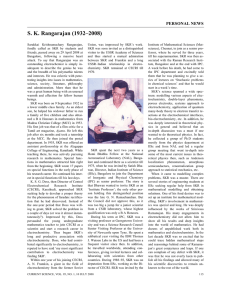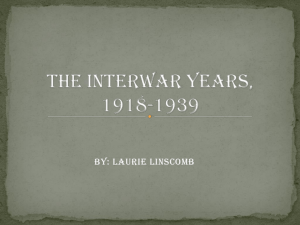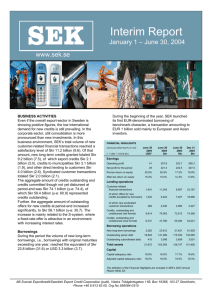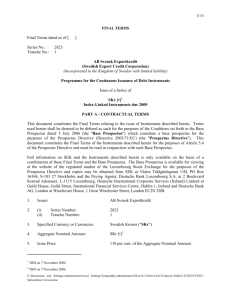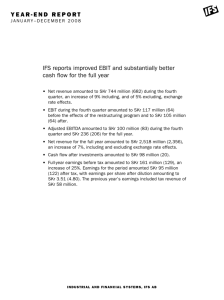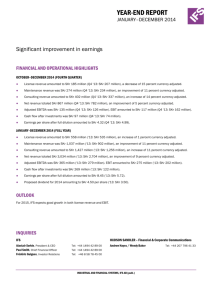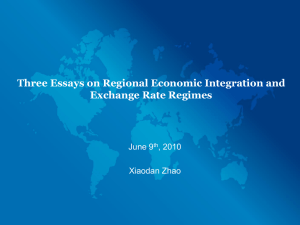Prof. Dr. Margrit Kennedy presentation - Co
advertisement
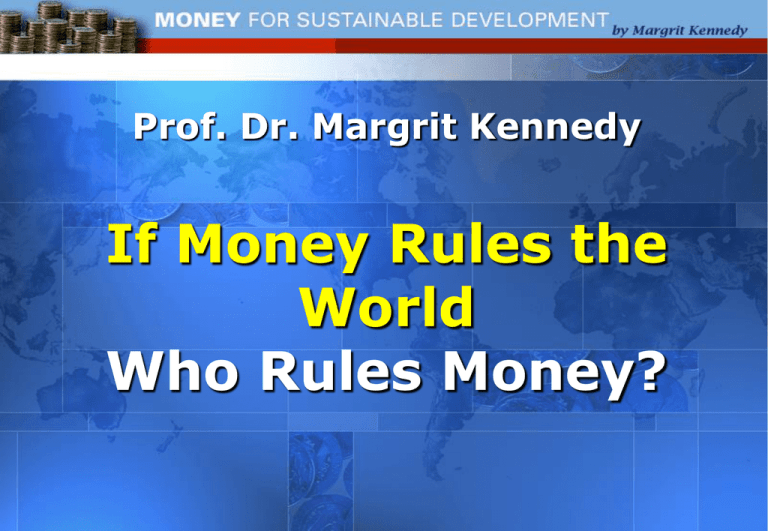
Prof. Dr. Margrit Kennedy If Money Rules the World Who Rules Money? Misconception 1: Money with intereest and compound interest can grow forever There exist different growth patterns in the material realm a. natural growth alone can be termed sustainable b. linear growth can be sustained temporarily c. exponentielles growth is soon coming to an end Source: H Creutz 2. The Transparency Misconception Interest is paid only when we borrow money 1 Garbage Collection Fees Cost of interest on capital 12% 2 Drinking Water Costs Cost of interest on capital 38% 3 Rent in Public Housing Cost of interest on capital 77% Source: H Creutz Misconception 3: Everybody is treated equally in the system Interest payments and Interest gains show large disparities: 80% of the population pays twice as much as they gain 10% gain more than twice as much as they pay Source: H Creutz Results: Widening Gap in Key Economic Indicators Yearly average in billion DM from 1950 - 1995 [All figures are inflation adjusted] Source: H Creutz Continual Inflation Because of inflation, in the year 2001, every DM was worth only 20 Pfennigs… and this was the most stable currency in the world! Source: H Creutz 3500 Excessive Increase in Foreign Exchange Transactions 2500 2000 Speculative Real 1500 1000 500 0 19 74 19 80 19 83 19 86 19 89 19 92 19 95 19 98 20 01 20 04 20 07 Billions of US$ 3000 Year Source: Lietaer Of Human Wealth 2008 Solutions: Interest Free Savings and Loan systems: The JAK-Members‘ Bank $ Savings Time Presavings Loan Loan Aftersavings Equity share Source: Mark Anielski, Canada Comparison of loan payments in normal bank and JAK Credit Period Monthly repayment Fees Monthly savings Total amount monthly Total amount 25 years Total savings Bank 200 000 SKr 25 years 1 568 SKr incl. JAK 200 000 SKr 25 years 667 SKr Interest of 8% 1568 SKr 190 skr 654 skr 1511 SKr 470 400 SKr 453 300 SKr 0 196 200 SKr Risk insurance: Shares in the JAK Co-operative 6% = 12 000 SKr as withdrawal in following year if there is no deficit Savings: 600 000 Bonus points = 2 years X 2000 SKr per month Components in Interest for Loans and Credit In the present money system In complementary money systems Bank Fees 1.7% Bank Fees 1.7% Risk Premium 0.8% Risk Premium 0.8% Liquidity Premium 4.0% Liquidity Premium 0.0% Inflationary Adjustment 1.5% Inflationary Adjustment 1.5% Total Total 8.0% 4.0% Comparison of Credit Costs for average German household with € 30.000 /year • interest costs of 40% • demurrage half of that • JAK-System one quarter € 12.000 / household /year € 6.000 / household /year € 3.000 / household /year An encompassing interest free savings and loan system, would reduce credit cost for the average German household to € 3.000 instead of € 12.000 / household/year My change of perspective between 1987 und 2004 Solutions: Designing Complementary Currencies Creating new financial liquidity for a limited purpose LOCAL, REGIONAL and GLOBAL CURRENCIES or SECTORAL CURRENCIES Sectoral CURRENCIES three examples Fureai-Kippu System, Japan WIR Wirtschaftsring, Switzerland Saber Educational Currency, Brasil Fureai-Kippu = Care Tickets since 1995 in Japan supports care of elderly with help from younger people who get hour credits which can be used at a later date in another part of the country or by another person WIR-WIRTSCHAFTSRING PARALLEL CURRENCY SYSTEM among small and medium businesses since 1934 in Switzerland 15 Swiss regional WIR- organisations 60.000 members average turnover per year 2.0 bio WIR proves to have anti-cyclical effect supports policies of government EDUCATIONAL CURRENCY „SABER“ Brasil: 40% of population under 15 years 1% surcharge on mobile phone bills =>1 bio US$ for education PROPOSAL: - Funds back vouchers for student tutorials - only universities redeem them - limited validity (-20%/a) - Educational BENEFIT equivalent to 10 billion US$ ...in addition: teaching others multiplies educational benefit again ten times => 100 bio US$ Differences between COMPLEMENTARY and TRADITIONAL currencies 1: use- instead of profit-oriented limited instead of general acceptance circulation incentive instead of interest transparent instead of obscure creation democratic instead of central control Differences between COMPLEMENTARY and TRADITIONAL currencies 2: inflation-resistant instead of inflation-prone promoting community instead of destroying it Differences between COMPLEMENTARY and TRADITIONAL currencies 3: a win-win solution for everybody instead of only ten percent of the population REGIONAL CURRENCIES: • partial decoupling from globalized economy • increased use of regional products and services • added value and surpluses remain in the region • community keeps its essential public utilities • closer links between consumer and producer • strengthening regional identity & diversity • reducing need for transport and energy A First Model for Regional Currencies: The Wörgl Experiment • • • • Circulation incentive of 1% per month or 12% per year Work-certificates worth 5.000 schillings circulated 400 times in 13.5 months Helped creating goods and services worth 2.000.000 schillings Town got 12% x 5.000 = 600 schillings for circulation incentives A First Model for Regional Currencies: The Wörgl Experiment Results in 13,5 months between 1932 - 1933: 1. Unemployment reduced by 25% 2. Town-Income increased by 35% 3. Public works investment rose by 220% Regional money system based on vouchers Figures for 2011: Annual turnover 6 mio Euros 2.388 Members 600 Firms 200 Associations Donations 50.000 Chiemgauer Total since 2003 210.000 Chiemgauer A Solution to the financial crisis in Greece and other European countries has been developed by the initiators and administrators of the Chiemgauer (soon also in English) http://www.eurorettung.org/ Sustainability of complex living systems Optimum 100% 0% Window of Vitality Resilience (Diversity + Interconnections) Efficiency (Streamlined) Sustainability of complex living systems Optimum 100% 0% Resilience (Diversity + Interconnections) Present Financial System Efficiency (Streamlined) Sustainability of complex living systems Optimum 100% 0% Effects of Complementary Currencies Resilience (Diversity + interconnections) Efficiency (Streamlined) Professional Support • Prof. Dr. Thomas Huth • Prof. Dr. Dirk Löhr • Prof. emer. Dr. Hans-Christoph Binswanger • Prof. Dr. Arno Gahrmann • apl. Prof. Dr. Dr. Helge Peukert • Dr. Eva-Maria Hubert • apl. Prof. Dr. Niko Paech • Prof. Dr. Joseph Huber • Dr. Hugo Godschalk • Dr. Raimund Dietz
